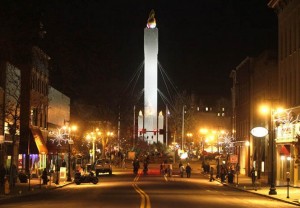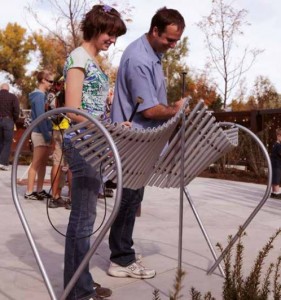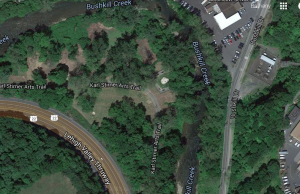Policy Analysis

The Policy Analysis of the KSAT Musical Playground includes the system of principles to guide decisions. Within the scope of the broad need to build a social commons where people can gather safely, this space will offer aesthetic pleasure as well as a social space for the Easton community. The wide range of social policies help to better frame the more logistical policies regarding zoning and political barriers. With few legal hoops to jump through, the primary focus of the musical playground is the atmosphere it will create and how it will fit not only the setting of the trail, but also the greater community of Easton, particularly the Historic District, West Ward, and College Hill, the regions nearest the trail. The interactive nature of the instruments promotes a space for users to interact not only with the instruments, but also each other, as well as any passerby using the trail but not the musical playground. The dynamic this creates promotes a participation space, an area where users are invited to enter and actively take part in making music. Music, by its nature, creates noise, so it is important to ensure the noise created pleases, or at least does not annoy, those who use only the trail.
The community of Easton currently lacks a social space where people can gather with their children. There are several parks located throughout the City of Easton, but none within the area of the KSAT. By creating a musical playground on the trail, we will increase the amount of civic spaces in the community. While a playground brings to mind an area geared towards a younger age group, usually those children 12 years and younger, given the location of this playground and the likely users, equipment and a setup geared towards all ages, from preschool to adulthood, best fit the context of the situation. The users of the KSAT range from mothers pushing strollers with toddlers running around to professionals jogging the trail before or after work. Students from Lafayette College frequently jog the trail too, as do pet owners who often let their canines loose in the dog park, located next to the proposed location of the musical playground. While installing slides, swings, and a jungle gym would appeal appropriately to the younger crowd, it would not actively draw participation from the many joggers. The point of the musical playground is not to make the joggers stop and use the equipment, but rather to offer an appealing setting, that, should they like to stop and interact for a few minutes, they find an intriguing setting to do so. With this goal in mind, musical instruments that create real music and look professional were chosen. These instruments can be installed at either an adult height or a toddler height, so to cater to all ages, some of the instruments could be installed at one level while others at another.
The atmosphere desired by installing the musical playground will further enhance the art theme along the KSAT, providing another sense the current static pieces do not: sound. From the Peace Candle constructed every year in the Center Square to the sculptures along the trail, those who walk by cannot help but notice the importance of art within the community. While the static pieces bring an element of thought and reflection, they fall short of actively engaging the observer in participation. The musical playground will overcome this limitation. Instruments installed next to the path invite them to come and participate, which “is, by its very nature, a dynamic activity” (Randell, 2004). To further the dynamics of participation, the instruments will be installed to face one another so that players can make eye contact, allowing for interaction not only with the instruments, but also with the other players.

By making music using the instruments, users will become part of the trail, adding to the art which decorates its open areas. Unlike the sculptures, which trail users do not observe until they come upon them, the instruments will be heard–provided other users are playing the instruments–before trail users actually see them, illustrating the expanded impact range the auditory senses has over the visual. In the same way an audience sits in a blackened auditorium and listens to an orchestra on stage, so approaching users, when hearing the instruments being played, will become a part of the music. The orchestra on stage strives to make the music meaningful to the listener, the obvious indicator of their success is the magnitude, enthusiasm, and length of the applause rendered at the end. On the KSAT, no orchestra is looking for applause, but as someone plays and users approach, the effect of whether the music effectively connects with them can be measured by whether they too, stop and play. The sound cannot help but invite them, and combined with the beauty and intriguing qualities of the instruments, they will hopefully take a moment or two and become a participant with the art surrounding the trail.
While the instruments along the KSAT will actively invite users to interact with them, the question remains how the addition of instruments will impact the existing structure of Easton. Isolated as the location is, no residential homes or office buildings will hear the instruments, and therefore the possibility of music late on a summer evening will not prevent young children from falling asleep or a businessman from hearing his client on the phone. The trail technically starts in the Historic Downtown, but the segment of the trail on which the musical playground will be installed is near the base of College Hill, closer to the West Ward. Historic Downtown has undergone some serious renovations in the last ten years to make the area more attractive and safe. Local bands regularly play during the farmers’ market or on summer evenings, so the addition of musical instruments fits into the culture of Historic Downtown.

Additionally, the multiple festivals held every year draw visitors from outside Easton, and although they would have to walk almost two miles to the instruments, it would provide another area of interest for those willing to make the trek. College Hill participants will include both college students and the stereotypical middle-class families with young children, both of whom will find the musical arrangement intriguing, and, more than likely, worth a visit. The West Ward is the last region from which regularly users can be expected. This region has the reputation as the rough area of Easton, so at the very least, the installment of a musical playground will provide a civic space for those residents to travel to and around which to gather. Overall, the addition of musical instruments along the KSAT fits into the overarching goal of community that city leaders are seeking to grow, as seen through the outdoor concerts and festivals held every year in Center Square. Community welfare will increase with the creation of a musical playground. By creating a space in the community where all are welcome and no one is limited by income, race, or any other factor, a stronger community is born. In order to create a space like this, there must be public resources available, such as a musical playground, that can create such a space.
This is where the KSAT Board comes into play. The KSAT Board has complete autonomy over the trail. and The City of Easton Department of Parks and Recreation completely backs the KSAT Board. Political Barriers are not a huge issue in the designing of the musical playground because of the unique political situation. The KSAT Board is supportive of the musical playground and is very willing to support its design and construction. At this time there are no political barriers that will impede the development of the musical playground on the KSAT.
Zoning also plays an important role in community development. According to the City’s website, when submitting a zoning permit application for new construction or additions/expansions of existing structures, a detailed site plan must be included showing the following information: property dimensions of both existing and proposed structures (square footage), the distance(s) between building(s) and property lines, the distances between structures, the location of impervious surfaces, and neighboring land uses. A complete layout and design of the musical playground can be found in the Technical Analysis.

Our biggest concern when building a civic space is the safety of the people who use the instruments there. The U.S Consumer Product Safety Commission outlined guidelines for safety in public parks in their Public Playground Safety Handbook (2010). While this handbook is not a list of official rules, it discusses considerations for safe, age appropriate play on playgrounds, such as equipment material, maintenance, and visibility. While these aspects are important areas to consider when installing the playground equipment, playground equipment that does not meet these guidelines would be the exception, so finding equipment that adhered to the policies was not difficult. All the companies ship throughout the United States, so there are no issues with Pennsylvania state regulations.
Musical instruments make noise, and ensuring the noise levels do not disturb non participants is important. Fortunately, the chosen location along the Karl Stirner Arts Trail has no houses or businesses in its immediate vicinity. Bordered by a cemetery on one side and a creek on the other, the instruments will not disturb any residents or businesses. For those passing by, they can expect noise levels of 80-90 decibels, which is equivalent to a garbage disposal, dishwasher, blender, or power mower. Freenotes Harmony Park publishes a complete study on the noise level of their instruments. As the measurements are given in decibels, Industrial Noise Control provides common examples of decibel ratings.
The policies of a civic space must work to meet the needs of a community to its highest ability as ensuring the health and safety of the community of Easton is a major priority. If policies do not meet these standards, projects will fail the community. The musical playground is designed to serve the community as a civic space in which families can have a safe place to gather and engage.
To read about the technical analysis involved in implementing a musical playground on the Karl Stirner Arts Trail, follow the link to the Technical Analysis.
